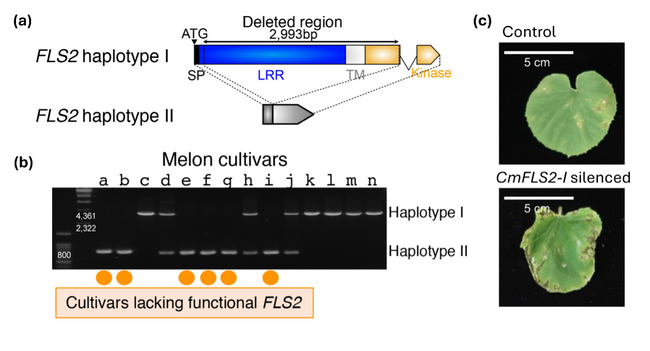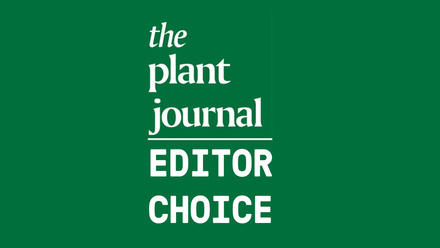July 2024 TPJ Editor choice: A gap in the defence: many commercially grown melon cultivars lack a functional FLS2 flagellin receptor
Highlighted publication:
A deletion in FLS2 and its expansion after domestication caused global dissemination of melon cultivars defective in flagellin recognition
https://doi.org/10.1111/tpj.16895
A gap in the defence: many commercially grown melon cultivars lack a functional FLS2 flagellin receptor
Pattern recognition receptors (PRRs) are a plant’s first line of defence against pathogens: these cell surface-localised receptors detect pathogen-associated molecular patterns (PAMPs) and trigger immune responses such as generation of reactive oxygen species (ROS), stomatal closure, activation of MAP kinases and production of defence hormones. The receptor-like kinase FLAGELLIN SENSITIVE 2 (FLS2) is a well-characterised PRR and is comprised of an extracellular leucine rich repeat (LRR) receptor domain, a single transmembrane domain and an intracellular kinase domain essential for signal transduction. FLS2 recognises the PAMP flg22, a 22 amino acid peptide of the bacterial flagellar protein flagellin. Arabidopsis fls2 mutants display enhanced susceptibility to the bacterium Pseudomonas syringae pv. tomato and silencing of FLS2 in tobacco and soybean increases susceptibility to other P. syringae strains.
While FLS2-like sequences have been identified in many dicots, few of them have been studied at the functional level. Jin and colleagues set out to investigate FLS2 orthologues in cucurbit crops. The commercial cultivars Suyo (cucumber) and Lennon (melon) both showed a ROS burst upon treatment with flg22, indicating an immune response to flagellin. Using BLAST searches, the authors identified a cucumber gene with high homology to Arabidopsis FLS2, which they designated CsFLS2. Virus-induced gene silencing (VIGS) of CsFLS2 significantly reduced ROS production upon flg22 treatment, suggesting that FLS2 function is conserved between Arabidopsis and cucumber.
To their surprise, Jin et al. could not find a clear orthologue of CsFLS2 in the melon cv. DHL92 reference genome. Instead, they retrieved a sequence that encodes a truncated protein lacking most of the LRR, transmembrane and kinase domains, which likely represents a pseudogene (Fig. 1a). Re-sequencing the genome of melon cv. Lennon, which responds to flg22, uncovered two haplotypes in the putative FLS2 region: a full-length FLS2 sequence with 96% amino acid sequence identity to CsFLS2 (CmFLS2 haplotype I) and a truncated version identical to the sequence in the DHL92 reference genome (CmFLS2 haplotype II).
Genotyping nine cucumber and twelve melon cultivars revealed variation in FLS2 genotype among cucurbits. While all cucumber cultivars exclusively harbour the full-length CsFLS2, only four melon cultivars were homozygous for full-length CmFLS2 haplotype I, two were heterozygous and six were homozygous for the truncated CmFLS2 haplotype II (Fig. 1b). Notably, only cultivars harbouring haplotype I (full-length CmFLS2) were able to produce ROS upon flg22 treatment.
Does a cultivar’s ability to react to flg22 also affect its immunity to Psl? To answer this question, Jin et al. performed a Psl inoculation assay with CmFLS2 haplotype I-silenced Lennon plants. The silenced line showed more severe symptoms and a higher bacterial load than the control. They observed similar results using the closely related commercial cultivars Harukei-3 (CmFLS2 haplotype II) and EDISTO 47 (CmFLS2 haplotype I), with Harukei-3 being more susceptible than EDISTO 47. These experiments indicate that a full-length CmFLS2 gene is critical for immunity against Psl.
The presence of the truncated CmFLS2 allele in many commercial melon cultivars seems puzzling given the importance of CmFLS2 for immunity. Senior author Yoshitaka Takano thinks three not mutually exclusive scenarios might explain this observation: the truncated CmFLS2 allele might be linked to a desirable trait; a functional CmFLS2 allele may not convey an advantage under current cultivation practices (allocating resources to immunity rather than growth when non-adapted bacteria are detected); or elite cultivars that were bred under lower bacterial pressure became the founders for modern melon breeding. Whatever the reason for the lack of functional FLS2, Takano is convinced that in today’s world bacterial pathogens such as Psl severely threaten the cucurbit industry. He hopes that his group’s research will help improve bacterial resistance in cucurbits, and that reintroducing or maintaining a functional CmFLS2 allele in commercial melon cultivars can be a first step towards this goal.

Figure 1. Many commercial melon cultivars lack a functional flagellin receptor.
- Schematic diagram of CmFLS2 haplotypes in melon: haplotype I contains a full-length FLS2 gene, while haplotype II harbours a truncated FLS2 gene missing large parts of the leucine rich repeat (LRR), transmembrane (TM) and kinase domains.
- Genotyping of the CmFLS2 locus in commercial melon cultivars. The large PCR fragment corresponds to CmFLS2 haplotype I and the small fragment corresponds to CmFLS2 haplotype II.
- Leaves of melon cv. Lennon plants after spray-inoculation with Psl. Plants were infected with a CmFLS2-I silencing vector or an empty vector control prior to treatment.
Figure modified from Jin et al.




